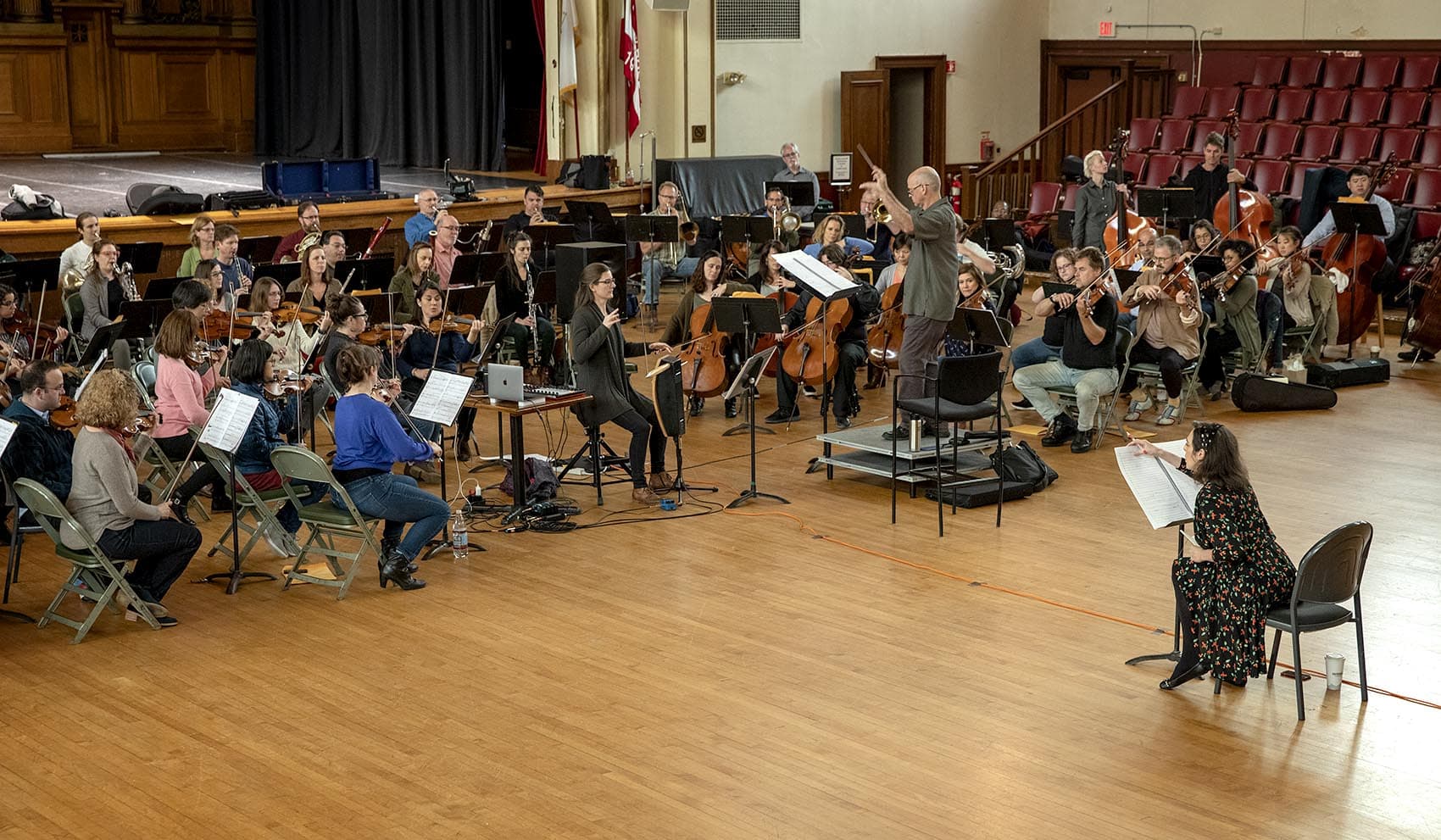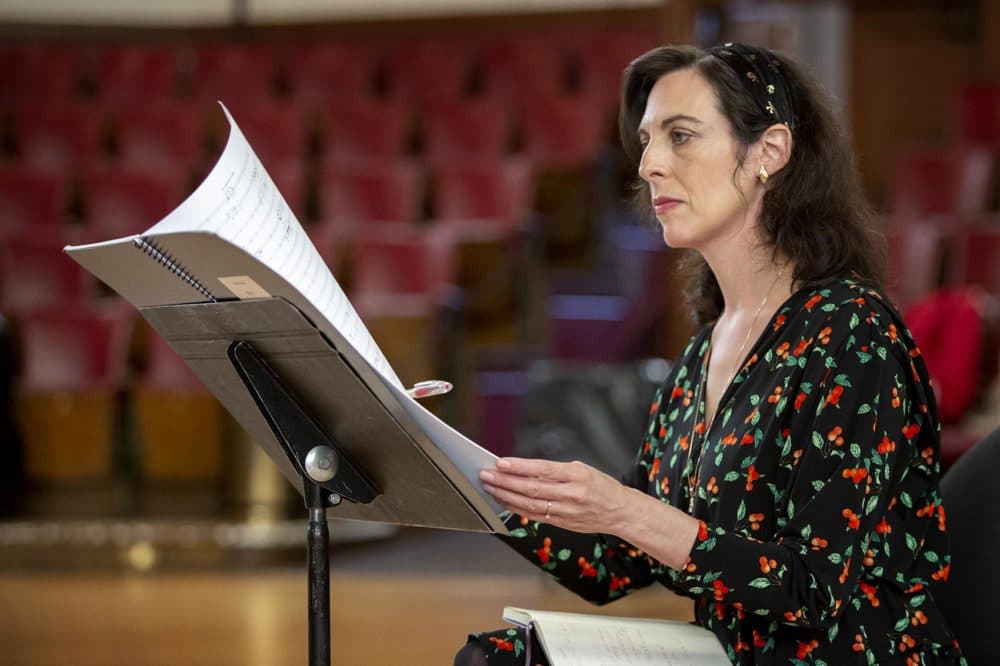Advertisement
Beyond Sci-Fi: The Theremin Gets A 100th Birthday Concert In Boston

Say the name "theremin" and there’s a good chance it will conjure up eerie soundtracks from horror or sci-fi movies, like 1951’s “The Day The Earth Stood Still.”
But Léon Theremin’s preternatural invention has been inspiring classical musicians and composers since it first wowed the world in 1920. To celebrate its upcoming 100th birthday, the Boston Modern Orchestra Project (BMOP) is celebrating the electronic instrument with a world premiere performance and a live recording.
At an afternoon rehearsal, BMOP’s percussion, string and wind musicians grasped their instruments as they worked their way through “Sirens,” a new concerto for theremin and orchestra. But sitting among them, 31-year-old soloist Carolina Eyck looked like she was playing the air between two antennae poking out of a metal and wood base. She acknowledges how odd it might seem to the uninitiated.
“If you don’t know the theremin, you might think somebody is waving their hands in the air, doing magic,” she explained. “But I can actually change the pitch with my right hand, and the volume with my left hand.”
Eyck’s hands dance, kind of like a conductor’s, inside an invisible, highly sensitive electromagnetic field. Their gestures evoke the articulated precision of sign language.
Eyck started playing the theremin as a kid in Germany when she was 7. “My parents bought me the instrument because they thought it was cool,” she recalled. “It just stuck with me and I always knew that the theremin would be my instrument.”
At first she performed for her stuffed animals and eventually moved on to human audiences.
“When I was on stage I always knew nobody knew what I was doing,” Eyck said in a whisper. The instrument’s mysterious nature clearly drew her in. When I asked where she’s living these days she jokingly answered, “outer space.”
But Eyck has been a seriously disciplined student of the theremin for most of her life. As a teen she studied with Lydia Kavina, whose grandfather was Leon Theremin's cousin. Eyck even created her own series of hand positions and is always eager to explain how she plays her instrument without ever touching it.
“I can play the scale, for example, by starting with a closed hand and then slowly opening my hand until all the fingers are stretched out,” she said, then demonstrated for an awestruck reporter.
Advertisement
Internationally acclaimed composer and thereminist Dalit Warshaw had Eyck in mind for her new concerto.
“Carolina possesses such versatility and musicianship, and her capacities are pretty much limitless," she said. "And there was no other performer I could have thought of to play this piece.”

Warshaw listened to the BMOP rehearsal from the sidelines, her "Concerto for Theremin and Orchestra" score splayed open on a music stand.
“There's no instrument like it, it’s an instrument of paradoxes,” she said.
Warshaw is attracted to the theremin for an array of reasons. She says electronic instruments don’t breathe, so in the case of the theremin its fluid, organic-feeling vocal lines can go on and on. Its vast range swoops to hit searingly high pitches (so high sometimes we can’t hear them) and shifts seamlessly to dark, low ones that rumble through our cores.
“The seductive aspect of writing for the theremin — for me — is the capacity to instill a human sound onto something completely mechanical,” Warshaw continued. “When a performer addresses this instrument there's always the tension between these two components.”
Warshaw wrote “Sirens” as an homage to her mentor, Clara Rockmore, who was one of the first classical musicians to embrace and popularize the instrument in the early 20th century. Rockmore, a fellow Russian, was also a muse for Léon Theremin.
He invented his pioneering instrument as a young physicist working for the Soviet government. He also developed a listening device known as “The Thing” that was used to eavesdrop remotely on the U.S. ambassador in Moscow.

It seems Theremin was as captivated by his instrument’s otherworldly sounds as the audiences who flocked to his popular performances in Europe and the U.S. He tweaked its abilities in a New York lab and got a U.S. patent for the theremin in 1928.
BMOP artistic director Gil Rose said whenever the orchestra explores the development of 20th century technology and classical music they always go back to Theremin.
“After World War I there was a freedom to express things and there was a new electronic age,” Rose explained, “so it was an attempt by composers and inventors to collaborate to increase the palette and tools for composers to use while writing orchestra music.”
Friday’s birthday concert also includes one of the earliest classical pieces written for theremin, Joseph Schillinger’s, “First Airphonic Suite” from 1929.
Rose said seeing a virtuoso play live is way better than hearing the theremin in a movie score or on a recording.
“It's fascinating,” he said — so fascinating that he has to warn the orchestra’s musicians to quit watching the thereminist and focus on their parts. But the conductor understands: “It's easy to get distracted, it’s a kind of mystical thing. It's both science and mysticism brought into the same realm.”
At the end of rehearsal BMOP violist Amelia Hollander Ames admitted she had trouble looking away from Eyck.
“Everything that we do involves actually touching our instruments,” the musician said, “so to see somebody playing the air is really incredible.”
Hollander Ames compared it to watching a dancer carving sounds with their hands.
“I mean there's something so vocal about it,” she added, “it really sounds like this ghostly voice.”
Pushing the instrument into uncharted territory and sharing its versatility drive Eyck. She just released a new recording where she blends the theremin’s voice with her own.
“I just wish that people are open-minded and take the sound in as they listen in the moment,” Eyck said, “and don't compare it to anything.”
Even at nearly 100 years old, Eyck says the theremin is still a relatively young instrument and its weirdly beautiful voice still has a long way to go. She's clearly excited to go on that journey, too.
The Boston Modern Orchestra Project is celebrating the theremin's 100th birthday with a performance that's being recorded Friday, Oct. 4 at Jordan Hall.
This segment aired on October 4, 2019.


